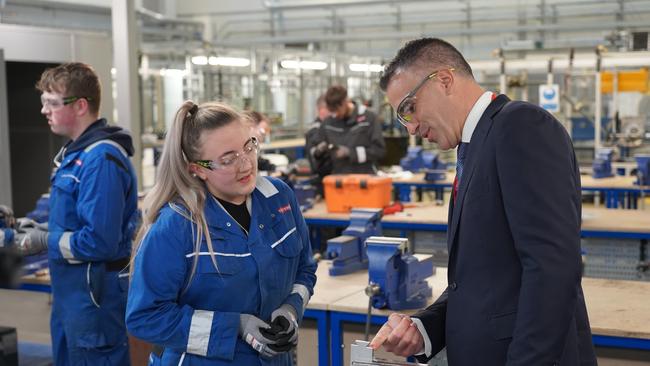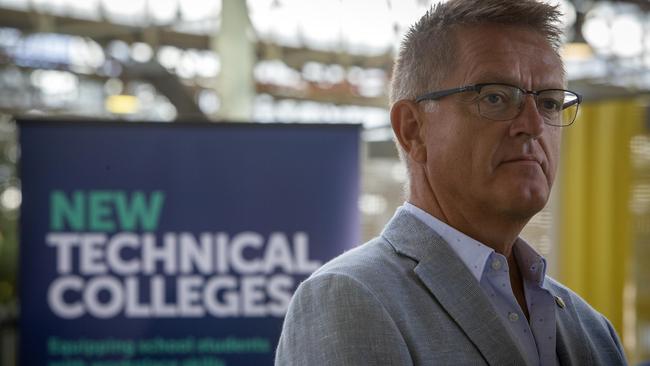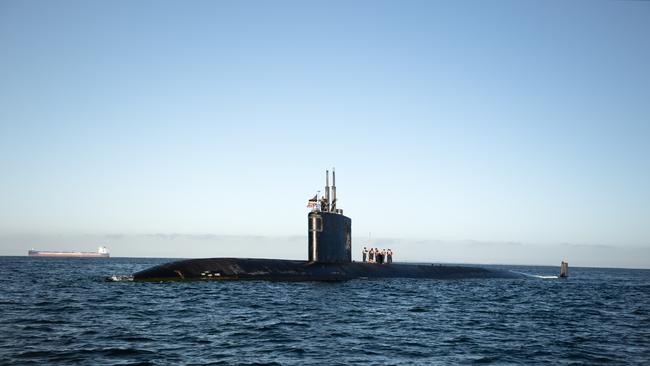‘Single biggest risk’: Premier’s plans to build skilled nuke subs workforce
Up and atom, kids. Premier Peter Malinauskas has a plan for schools to reduce the “single biggest risk” to Adelaide’s nuclear-powered submarine construction.
SA News
Don't miss out on the headlines from SA News. Followed categories will be added to My News.
Nuclear skills programs should be injected into primary and high school studies to prepare future workers for Adelaide-based submarine construction, says Premier Peter Malinauskas.
In an interview with The Advertiser, Mr Malinauskas said one of his first meetings after returning from his three-day United Kingdom trip would be to ask Education Department chiefs to plan ways to insert nuclear studies and associated skills into the curriculum.
Mr Malinauskas said his meetings in the UK had reaffirmed his view that building a skilled workforce was the “single biggest risk” to the Adelaide nuclear-powered submarine construction.
He said meetings with UK defence officials and industry leaders had emphasised the importance of integrating school curriculum with university and vocational training.
Asked if this would involve specialist additions to the primary and high school curriculum or outreach programs like those in the UK, Mr Malinauskas said: “I think they’re all the options that we’re going to have to speak to the Education Department about … It will be one of the first meetings we have.”

Part of this would involve the government’s soon-to-be-created technical colleges but he said this would not meet the looming demand.
“Only so many children will go through the technical college program, and the number of people that we need to get access to here is so much greater than that,” Mr Malinauskas said.
“So quickly upon coming home, we’ll have to think about what architecture we put in a bureaucratic and policy context to actually facilitate this, beyond just the traditional efforts of telling kids to do more STEM.”
There is support within government for STEM (Science, Technology, Engineering and Maths) programs to gear up for nuclear submarine construction that do not further burden teachers but recognise the importance of rapidly developing students’ qualifications for university and vocational training.

UK nuclear submarine builder BAE Systems, whose Barrow-in-Furness yard and skills academy Mr Malinauskas visited on Thursday, has curriculum support programs involving universities and primary and high schools, backed by more than 350 STEM “ambassadors”.
This ranges from six STEM activities based around fairy tales, including Goldilocks and the Three Little Pigs, to after-school clubs run by STEM ambassadors, Lego Robotics and a future engineers program for year nine students.
Mr Malinauskas told The Advertiser there was “lots of work to be done to take kids out of the school setting and invite them to experience, touch and feel the career opportunities that will be provided through the AUKUS submarine program”.
“The federal government has made a commitment to build nuclear submarines in South Australia. That will happen. But if you were to take a cynical approach, as some people have, and ask yourself: ‘What would it take for this endeavour to not succeed?’ – it will be because we haven‘t developed the workforce that is required,” Mr Malinauskas said.
”So as a state government, we bear a lot of that responsibility, because everything from kids in preschool through to kids in TAFE, and everything in between, we’re exclusively responsible for.
“This is going to take a lot of collaboration between the state and federal government in a way that I didn’t fully realise until I actually met with industry here in order to be able to deliver the workforce as required. We don’t have a lot of time.”

Flinders University vice-chancellor Colin Stirling, who announced tertiary nuclear course partnerships in London, told The Advertiser schools needed to be able to focus on STEM subjects, particularly maths, because too many pupils were dropping out too early.
This meant universities were taking in students who had not done advanced maths, then having to teach them that curriculum.
“If the schools haven‘t done it, then what’s the alternative? We don’t generate enough engineers. Now, that doesn’t make any sense,” he said.
“So it would be so much easier for us if the schools and the school structure and the school curriculum, encouraged more pupils to finish all those maths skills at school, because then they’d have a simpler choice in the future.”
Professor Stirling said the education policy response was not easy but argued part of the issue was about conveying to pupils and their parents the opportunities for challenging and lucrative careers.
He said Flinders outreach activities encouraging Year 9 girls to continue STEM subjects could be easily incorporated into primary and high school curriculums.
Between 700 to 800 girls already had been involved and 90 per cent had continued with STEM subjects in their senior years at high school.
Rolls-Royce of nuclear
Up to 85 per cent of the 5500 workers building AUKUS submarines in Adelaide would require nuclear skills, says a Rolls-Royce executive whose firm will supply the reactors.
Rolls-Royce Submarines director engineering and technology Lee Warren, in a meeting with Premier Peter Malinauskas, said the level of nuclear skills intensified the more closely the worker was to the reactor on the production line.
Mr Warren offered to create places for Australian trainees in Rolls-Royce’s newly created nuclear skills academy, also telling Mr Malinauskas the training blueprint could be exported to set up a planned Adelaide skills academy.

Rolls-Royce Submarines was announced on March 13, as part of the AUKUS agreement, as the nuclear reactor provider for Adelaide-built submarines.
Mr Warren told The Advertiser the Premier had asked him the proportion of nuclear skills required for the Adelaide construction, given Rolls-Royce would supply the completed reactor to be installed in the submarines.
“There‘s different groups of skills that are still required to take on the stewardship of that nuclear system, correctly install it in the submarine, and then go on to look after it throughout its life and maintain it,” Mr Warren said.
”My judgment was you’d probably still need 80 to 85 per cent of the skill sets that we would have to be able to do everything – making the actual fuel components right the way through to support.”
Mr Warren likened the level of skills to a tail, decreasing in complexity as the workers’ responsibilities moved further away from the detailed nuclear core of the propulsion plant.
“It’s a slight oversimplification because the power module, as we call it, that will be will be given across to Australia directly,” he said.
“(But) all the pipe work and all the very complex systems, the control and instrumentation that enables the operators to press a button or turn a valve and all the magic happens – all of that the installation of it and the safety, criticality of those buttons, those screens, those valves -that‘s what I’m talking about in terms of the tail.”

Mr Warren distinguished between high-level nuclear skills and skills for nuclear.
“So, even if you’ve not actually got your hands on the detailed nuclear product, or are designing it or supplying it, there’s a nuclear requirement around most of what we do,” he said.
“High integrity products, treating them with extra care. Special cleanliness requirements. Some specific requirements on the type of materials that we use, that sort of thing – so you need to really have that whole understanding.”
Rolls-Royce Submarines employs more than 4000 people at Derby, about 200km north of London, and last September opened a Nuclear Skills Academy there to provide 200 apprenticeships annually for at least the next decade.
Rolls-Royce designs, manufactures and provides in-service support to the pressurised water nuclear reactors that power every submarine in the Royal Navy’s fleet.
This includes the Astute and Dreadnought boats built at BAE Systems’ Barrow-in-Furness shipyard, which Mr Malinauskas visited on Thursday.
Rolls-Royce Submarines president Steve Carlier said supplying the reactors for Australian submarines was “great news for Rolls-Royce and for the country as a whole with the creation of more UK jobs and an opportunity to showcase British innovation and expertise on the world stage.
More Coverage
Originally published as ‘Single biggest risk’: Premier’s plans to build skilled nuke subs workforce
Read related topics:AUKUS





